There’s nothing worse than buying a beautiful new timepiece only to find out it’s a fake.
But with the proper knowledge, you can spot counterfeits in just a few simple steps.
So even if you got your watch as a gift or plan to buy one yourself, you can be confident about your watch’s authenticity.
In this article, you’ll learn everything you need about real and fake IWC watches.
Continue reading to find out:
- 9 simple steps to spot a fake IWC watch.
- Strong signs that your IWC watch is genuine.
- 3 helpful tips in case you have a fake IWC watch.
- And more…
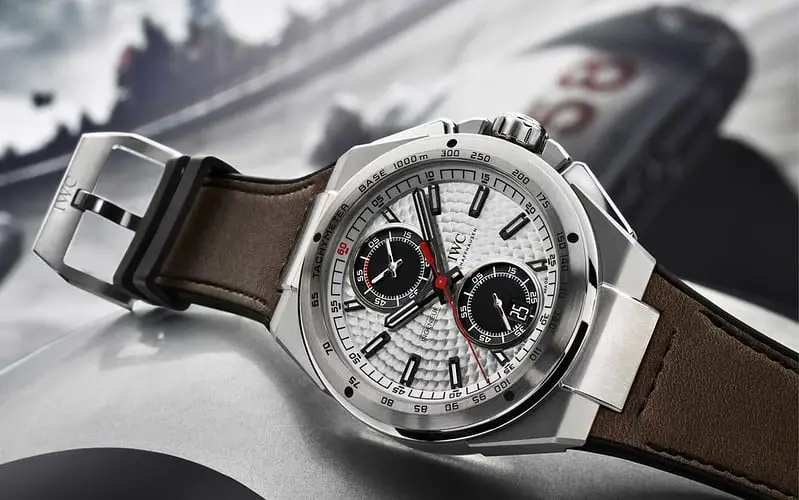
Table of Contents
How To Spot A Fake IWC Watch In 9 Simple Steps
Step 1: Check the crystal’s quality
The crystal of a watch is the piece of ‘glass’ that covers the face. For this, there are 3 options:
- Acrylic glass.
- Mineral glass.
- Sapphire crystal.
It’s important to know that IWC watches always have a sapphire crystal, as this can easily help you identify a fake.
Now, a sapphire crystal isn’t an actual gemstone. Instead, it’s lab-made with pure aluminum oxide.
Through the process of crystallization, this material turns exceptionally durable. In fact, it grows so durable that it can only be scratched by diamonds.
Therefore, you shouldn’t notice any scratches on the watch’s crystal. None whatsoever.
That’s because fake watchmakers can’t afford to use a real sapphire crystal on their watches. So if you see any scratches on the glass, it clearly indicates that the watch is made with sub-par materials.
In other words, it’s a fake.
However, not every counterfeit IWC will have scratches on the face. Some will appear as good as new.
But luckily, there is another way to check whether or not the watch has a genuine crystal.
To do so, just add a drop of water to the crystal.
Now, a fake crystal will make the water spread. Meanwhile, a real sapphire crystal will keep the droplet intact.
Step 2: Observe the details in the dial
Luxurious watches like IWC’s are full of tiny details.
Now, you do need somewhat of a trained eye for this. And even then, some fake watchmakers are getting really good at replicating.
But most fake watchmakers can’t replicate those tiny details all that well.
For starters, you can check the colors of the hands, numbers, and hour markers.
For authentic IWC watches, the colors of the hands should match.
Meanwhile, fake watchmakers might use unmatching colors on those parts. This makes the watch look unprofessionally designed. And that’s not something an authentic IWC has.
Aside from that, you might notice that some parts of the dial appear more saturated than others.
For example, your watch’s hands are colored gold. And it resembles the tone of beach sand.
However, a fake watchmaker may end up making 1 or more of the hands appear more yellowish than sandy gold.
This is another sign of a fake IWC watch.
With the colors, it mainly comes down to this; do you notice any discrepancies?
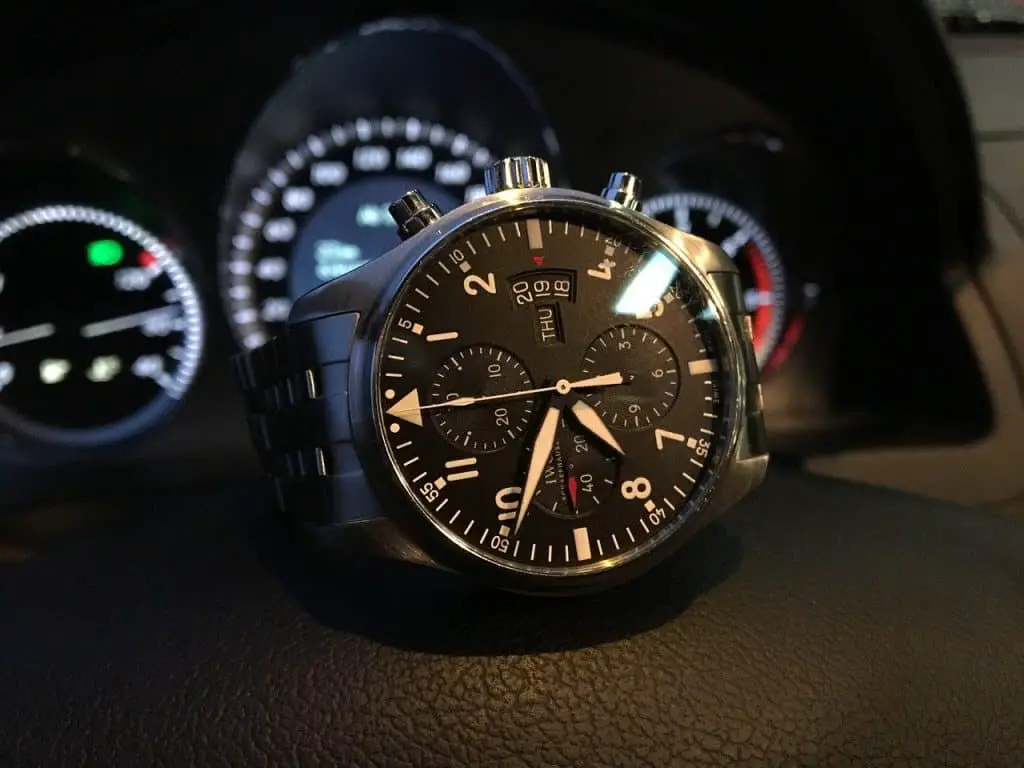
The font style
Aside from the colors, take a look at the font used on the watch.
If the numbers or letters appear too big and thick, then that’s another red flag for counterfeits.
That’s because genuine IWC watches are designed with thin lettering. This gives a much cleaner and more elegant look to the watch.
And since we’re talking about the letters or numbers in the dial, those parts should also be carved neatly.
However, fake watchmakers may end up carving the letters or numbers unevenly. And in some cases, they’ll only glue the numbers on the watch instead.
Size inconsistency
Authentic IWC watches are perfectly designed with symmetry.
However, fake IWC watches often show inconsistencies when it comes to the size of each part.
For example, 1 or more of the hour markers can be bigger than the others. Or they can also be shorter than the rest of the markers.
Inconsistent number of minute markers
Pay attention to the minute markers too.
A watch always has 4 ticks between the minute markers. This is one tick for every minute.
However, fake watchmakers sometimes add or detract a tick. So instead of the correct 4 ticks, there may be 3 or 5.
You see, indifferences like these will never occur in genuine IWC watches. And not to mention that it’s just plain wrong.
Step 3: Look at the date window
Every IWC watch model has a unique date window design.
Thanks to this, you can quickly check your watch’s authenticity by going online.
You just have to search for your IWC watch’s model on the company’s official site.
From there, you can compare if the date window matches the design on your IWC watch.
If it doesn’t match the sample on the website, then that’s a huge giveaway that your watch is fake.
Also, if it looks somewhat off or poorly thrown together, that’s another sign of the watch being fake.
Step 4: Examine the subdial
Some fake watchmakers won’t bother following the right layout of watch designs.
This means you’ll often find the subdial located in the same place. To be specific, fake watchmakers may place the subdial near the center of the watch.
Plus, they also make the subdial smaller.
Now, this is something you won’t see in a real IWC watch. That’s because the real watchmakers use an intricate layout for IWC watches.
After all, placing each part in the correct position affects the watch’s functionality.
That said, you can test your watch’s subdial by pressing the crown and pushers on the right side.
If it’s not working, that’s already a massive sign of a fake IWC watch.
However, second-hand watches might have a damaged subdial. But that’s something the seller should tell you about, as it means your IWC watch is in need of a service.
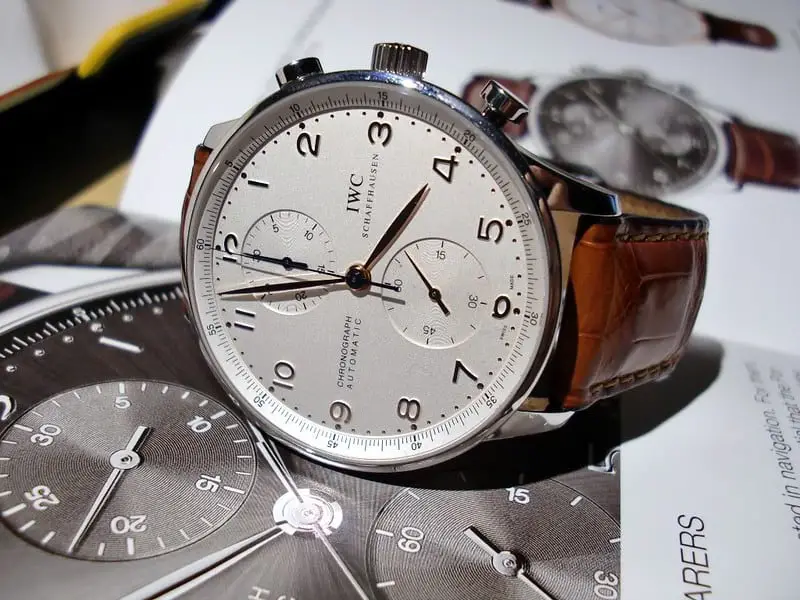
Step 5: Look at the crown
Fake watchmakers don’t have time to properly carve out the crown on the watch. As a result, you might notice the entire crown looking like it’s glued on the watch’s case.
Plus, they often make the crown thicker than usual.
Meanwhile, authentic IWC watches have slim, engraved crowns.
However, this doesn’t apply to IWC’s Pilot’s Perpetual Calendar watches. Those are pilot watches, which typically have a larger crown as part of their design.
And it’s easier to notice this crown as it sticks out nicely on the case, which perfectly suits the overall design of the watch.
That being said, most fake watchmakers won’t bother matching the crown to the design of a watch.
Step 6: Observe the case
IWC watches are made with high-end materials like titanium or high-end stainless steel. These materials are not only durable but also have some weight to them (except for titanium, which is ultra light!).
Meanwhile, this weighty feel cannot be found in counterfeits. They tend to be made with sub-par materials that are of lesser quality.
Counterfeit watchmakers tend to make the case a little bulkier to compensate for the lack of ‘weight’. This adds some artificial weight to the watch, and it makes it appear more ‘elegant’.
However, that doesn’t match IWC’s sleek designs.
It’s merely an attempt to make the watch look real, but in reality, it does the opposite.
Now, IWC watches are a little larger than most other brands, but the brand is an actual watchmaker. If anything looks out of place or sloppily finished, it’s a clear sign that the watch is fake.
You may also notice some scratches on the case as well.
Typically, IWC cases are made with durable materials, so seeing lots of scratches is a red flag.
However, if you’re buying a second-hand IWC that was worn a lot by the previous owner, a few scratches here and there are to be expected.
In any case, you should ask the seller to disclose how old the watch is and how often it was worn. With that, you’ll know what to expect with the watch’s condition.
Step 7: Check the bracelet or strap’s quality
The bracelets of IWC watches come in a variety of designs.
Luckily, these designs aren’t just for show. The thing is, each one has a unique purpose.
For example, a real IWC watch with a stainless steel strap can be slightly adjusted. And the watch owner can do this by simply pushing a button on the IWC’s logo.
By lightly pushing or tugging on the bracelet, you can slightly adjust the size of the bracelet.
Santoni leather
On the other hand, some IWC watches are paired with Santoni leather straps. And this material comes from alligator leather.
Now, this type of leather gives off a matte texture. It may appear like glossy plastic too.
However, fake watchmakers will try to copy this. But since they can’t afford to use alligator leather, fake IWC watch straps are typically made with plastic.
That’s why the appearance won’t be as glossy as a real Santoni leather strap.
And you’ll also feel the huge difference in texture the moment you hold a fake IWC watch.
Swap feature
There’s also the Aquatimer collection from IWC. Watches under this collection have a feature that lets you swap out the watch straps.
And you can either use a metal bracelet or a rubber strap.
Now, most fake watchmakers can’t offer these features in their IWC watches.
For one, it’s not easy to copy the design of these straps and make them functional. Lastly, fake watchmakers can’t afford the high-quality materials to replicate a real IWC watch.
Note: Second-hand IWC watches may have damage on the strap. This isn’t anything unusual.
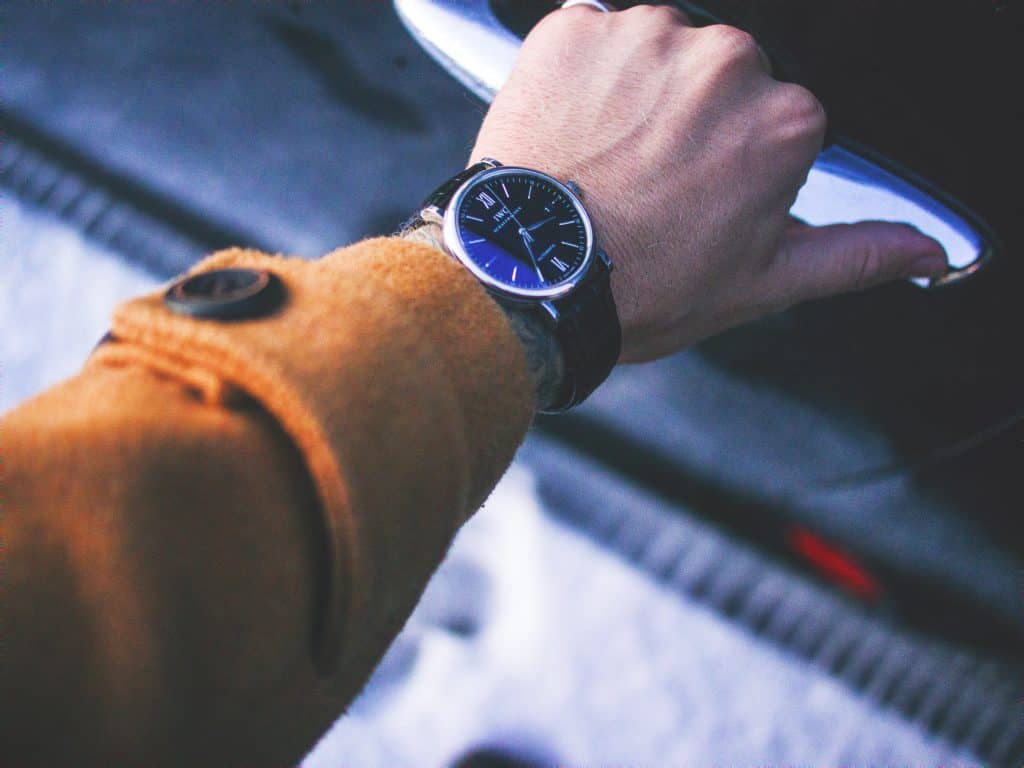
Step 8: Verify the serial number
IWC watches contain serial numbers. And these digits indicate the year the watch was created.
Now, you can find these numbers on the back of the watch. That said, you should only find numbers there.
If it shows an alphanumeric code, that’s a quick way to tell that your IWC watch is fake.
To give you an example as a reference, check out the table below:
| Year of Manufacturing | IWC Serial Number |
|---|---|
| 1950 to 1955 | 1200401 – 1335400 |
| 1955 to 1960 | 1335401 – 1513000 |
| 1960 to 1965 | 1513001 – 1778800 |
| 1965 to 1970 | 1778801 – 1970200 |
| 1970 to 1975 | 1970201 – 2265400 |
This table shows the serial numbers from very old IWC watches, but the same trend continues for the more recent models.
However, sometimes you’ll find that your watch matches the serial numbers. What then?
Well, some fake watchmakers might write down a false serial number. In that case, you can check some things.
The serial number shows the year of production. Meanwhile, you can look up when a certain watch was released or when they stopped producing a certain model.
So if your serial number tells you the watch was produced in 2002, but the watch was released to the public in 2006, it’s a clear sign it’s a fake.
But sometimes, the counterfeit watchmakers get the serial number correct. But if you’re still unsure, you can get the number verified at any legitimate IWC boutique in your area.
Or you can also send your watch to Schaffhausen to check the authenticity of your IWC watch.
If it’s genuine, you’ll receive a certificate of authenticity.
Tip: Whether you’re buying a brand-new IWC watch or a second-hand one, you should always ask for the certificate of authenticity right away.
This is a quick way to find out if the watch dealer you’re talking to is legitimate or not.
If the dealer doesn’t have the certificate, it’s a sign that they’re just selling a fake watch.
Step 9: Beware of cheap prices
As I mentioned before, IWC is a luxury watch brand. And that’s why real IWC watches are quite expensive.
Generally, each piece starts at $5,000. Meanwhile, some of their watch models can go as high as $46,500 or more.
Moreover, IWC watches hold their value well. After a few years, some of their watches even go up in price.
So if someone’s selling an IWC watch to you for a suspiciously low price, then that’s a huge sign of it being a fake.
The only expectation may be when you’re buying one second-hand. Maybe the seller isn’t too versed in the watch world and sells his authentic piece for slightly below market value.
But here goes the age-old saying: ‘If it’s too good to be true, it probably is’.
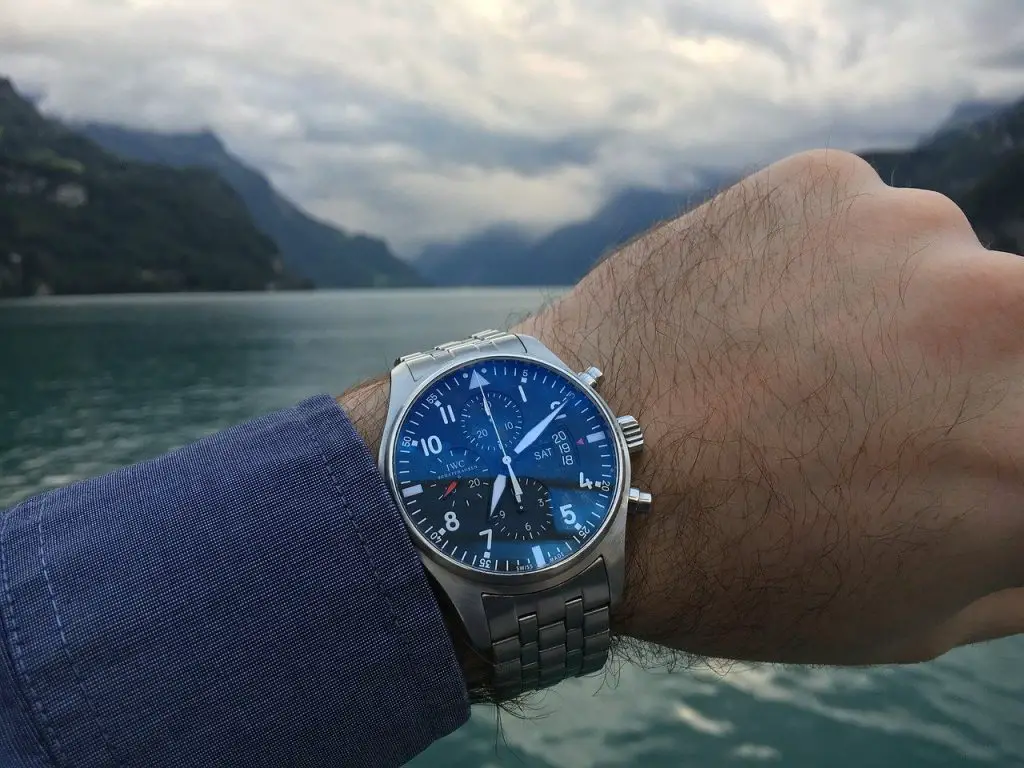
What to do if you have a fake IWC watch
Given that IWC is a famous brand, it’s no surprise that fake models are everywhere.
So, what can you do in case your IWC watch is counterfeit?
First, the official site of IWC says that you can report a false product. And you can contact the IWC Concierge by either calling their phone number or emailing them.
To find out your IWC’s Concierge phone number, you just have to select your country at the bottom of IWC’s faq page.
After speaking to them, IWC will advise you on what to do with the watch.
But as a safety note, you should know that a fake watch might contain harmful materials in them. This can put your health at risk in the long run.
In that case, you might want to return the watch to the seller and ask for a refund.
That said, I have some extra tips for you if you paid online or through PayPal.
3 tips for online shoppers if you bought a fake IWC watch
There are 2 payment methods in PayPal, those are:
- Friends and Family.
- Goods and Services.
Now, if you paid through “Friends and Family”, you can request a refund just by opening your PayPal app.
To make this easier, you can contact customer service for faster assistance.
Meanwhile, paying through “Goods and Services” means you’ll have to file a formal dispute charge.
This means you’ll have to prove to PayPal that you were scammed. And you can do this by talking on the phone with their customer service.
Lastly, you can contact your bank and file a chargeback case.
This means they’ll forcibly try to take your money back from the scammer’s account.
However, keep in mind that not all banks offer this service. And even if they do, it might be a long process that’s not guaranteed to work at all times.
